Printable primary worksheets
All of our resources come complete with answer sheets to save time for busy teachers and parents. Input your child’s scores and keep track of your child's progress.
worksheet plans from £3.20/monthAll of our resources come complete with answer sheets to save time for busy teachers and parents. Input your child’s scores and keep track of your child's progress.
worksheet plans from £3.20/month New
New
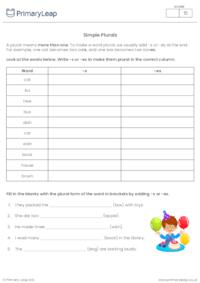
This worksheet introduces Year 1 students to plurals and how to form them using -s and -es. The activities include identifying plurals by writing -s or -es in the correct column and filling in blanks with the correct plural forms. This worksheet is designed to be engaging and easy to understand, making it perfect for young learners to grasp the basics of plurals.
 New
New
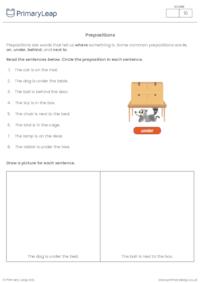
This worksheet helps Year 1 students understand and identify prepositions, which are words that tell us where something is. The activities include circling the prepositions in given sentences and drawing pictures to match specific sentences. This engaging worksheet is perfect for young learners to grasp the basics of prepositions and how they are used in sentences.
 New
New

This worksheet introduces Year 1 students to the concept of articles and how to use them in simple sentences. The activities include filling in blanks with the correct articles, circling the correct article in sentences, and writing the proper article for pictures. This worksheet is designed to be engaging and easy to understand, making it perfect for young learners to grasp the basics of using articles.
 New
New
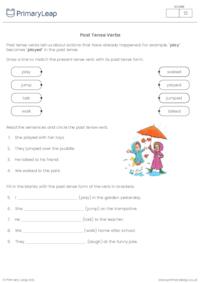
This handy worksheet introduces Year 1 students to the concept of past tense verbs. The activities include matching present tense verbs with their past tense forms, identifying past tense verbs in sentences, and filling in blanks with the correct past tense verbs. This worksheet is designed to be engaging and simple, perfect for young learners to understand and practise using past tense verbs.
 New
New
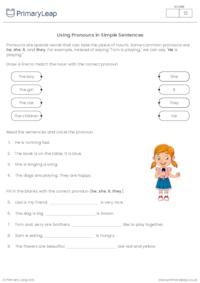
This worksheet introduces Year 1 students to the concept of pronouns and how to use them in simple sentences. The activities include matching nouns with the correct pronouns, identifying pronouns in sentences, and filling in blanks with the appropriate pronouns. This worksheet is designed to be engaging and easy to understand, making it perfect for young learners to grasp the basics of pronouns.
 New
New
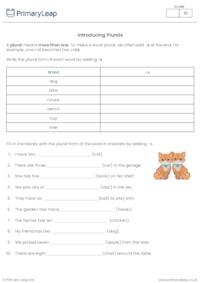
This worksheet introduces Year 1 students to plurals by adding -s. The activities include writing the plural forms of words and filling in the blanks with plurals. This worksheet is designed to be engaging and simple, perfect for young learners to understand and practise plurals. It helps develop basic grammar and vocabulary skills, making it an excellent resource for teachers, parents, and tutors.
 New
New
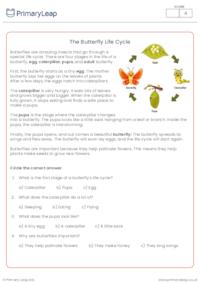
Dive into the fascinating world of butterflies with this engaging reading comprehension worksheet, perfect for Year 2 students. This resource presents a captivating story about the butterfly life cycle, from the tiny egg to the beautiful adult butterfly, followed by multiple-choice questions that will test and enhance students' understanding. Ideal for both classroom use and home practice, this worksheet not only builds reading comprehension skills but also enriches students' knowledge of nature. It's a delightful way to combine learning and fun, making it a valuable tool for teachers, parents, and tutors alike.
 New
New
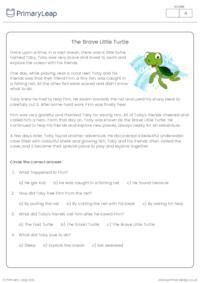
This engaging reading comprehension worksheet provides a fun and informative passage about The Brave Little Turtle, followed by multiple-choice questions to assess understanding. Suitable for classroom use or home practice, this worksheet helps young learners develop their reading comprehension skills. This worksheet helps develop reading comprehension and retention skills, making it an excellent resource for teachers, parents, and tutors.
 New
New
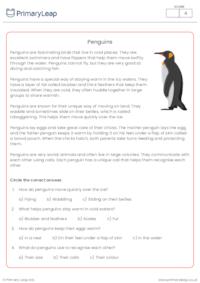
This engaging reading comprehension provides a fun and informative passage about penguins, followed by multiple-choice questions to assess understanding. Suitable for classroom use or home practice, this worksheet helps young learners develop their reading comprehension skills.Text Highlights:Penguins' swimming and diving abilitiesHow penguins stay warmPenguins' unique movements on landCare of penguin chicksPenguins' social behaviour and communicationQuestions:Multiple-choice questions based on the textThis worksheet helps develop reading comprehension and retention skills, making it an excellent resource for teachers, parents, and tutors.
 New
New
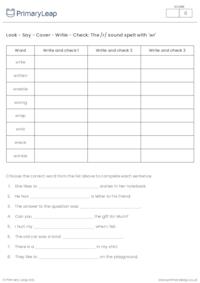
This worksheet helps children learn to spell words with the /r/ sound spelt with 'wr', following the UK curriculum. It uses the Look - Say - Cover - Write - Check method to make spelling practice fun and effective.Aims:Help children recognise and spell words with the /r/ sound spelled with 'wr'.Practise using the Look - Say - Cover - Write - Check method.Use correct spelling in sentences.How to Use:Have your students follow the Look - Say - Cover - Write - Check steps for each word.They should write the word in the first column, then check and correct it if needed.Repeat for the second and third columns.Students then complete the sentences using the correct words.
 New
New
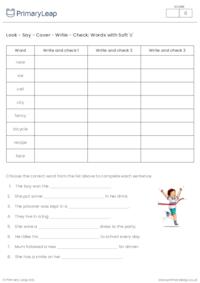
This worksheet helps children learn to spell words with the /s/ sound spelt with 'c' before e, i, and y, following the UK curriculum. It uses the Look - Say - Cover - Write - Check method to make spelling practice fun and effective.Aims:Help children recognise and spell words with the /s/ sound spelt with 'c' before e, i, and y.Practise using the Look - Say - Cover - Write - Check method.Use correct spelling in sentences.How to Use:Have your students follow the Look - Say - Cover - Write - Check steps for each word.They should write the word in the first column, then check and correct it if needed.Repeat for the second and third columns.Students then complete the sentences using the correct words.
 New
New
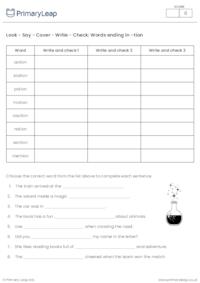
This worksheet helps children learn to spell words ending in –tion, following the UK curriculum. It uses the Look - Say - Cover - Write - Check method to make spelling practice fun and effective.Aims:Help children recognise and spell words ending in –tion.Practise using the Look - Say - Cover - Write - Check method.Use correct spelling in sentences.How to Use:Have your students follow the Look - Say - Cover - Write - Check steps for each word.They should write the word in the first column, then check and correct it if needed.Repeat for the second and third columns.Students then complete the sentences using the correct words.
 New
New
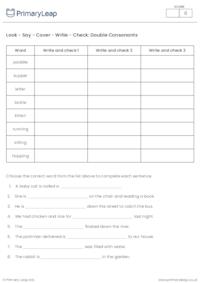
This handy worksheet helps kids learn to spell words with double consonants. It uses the Look - Say - Cover - Write - Check method to make spelling practice fun and effective.Aims:Help children recognise and spell words with double consonants.Practise using the Look - Say - Cover - Write - Check method.Use correct spelling in sentences.How to Use:Have your students follow the Look - Say - Cover - Write - Check steps for each word.They should write the word in the first column, then check and correct it if needed.Repeat for the second and third columns.Students then complete the sentences using the correct words.
 New
New
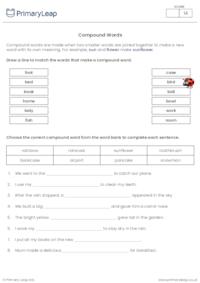
This engaging worksheet is designed for students to practise creating and identifying compound words. Suitable for classroom use or home practice, it includes fun activities to help young learners understand and use compound words in sentences.Activity 1: Students will match pairs of words that combine to form compound words.Activity 2: Students will choose the correct compound words to complete sentences, reinforcing their understanding.This worksheet helps develop reading, spelling, and vocabulary skills, making it an excellent resource for teachers, parents, and tutors.
 New
New
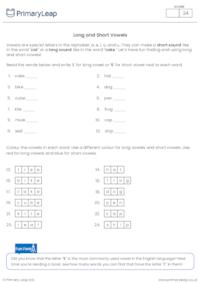
This engaging worksheet will help students practise identifying and using long and short vowel sounds. Suitable for classroom use or home practice, it includes fun activities to help young learners understand the difference between long and short vowels.Activity 1: Students will identify and label words with long or short vowel sounds by writing 'L' for long vowels and 'S' for short vowels next to each word.Activity 2: Students will colour the vowels in each word, using different colours for long and short vowels. For example, they can use red for long vowels and blue for short vowels.This worksheet helps develop reading and phonics skills, making it an excellent resource for teachers, parents, and tutors.
 Free
Free
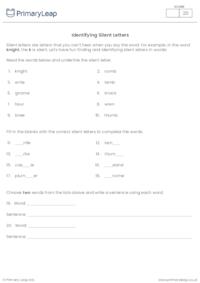
This engaging worksheet will help students practise identifying silent letters in words. Suitable for classroom use or home practice, it includes fun activities to help young learners understand and recognise silent letters.Activity 1: Students will read words and underline the silent letter.Activity 2: Students will fill in the blanks to complete words that contain silent letters.Activity 3: Students will choose two words from the list and write a sentence using each word, reinforcing their understanding and usage of silent letters.This worksheet helps develop spelling skills and enhances vocabulary, making it an excellent resource for teachers, parents, and tutors.
 New
New
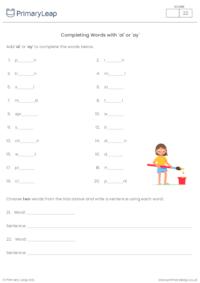
This worksheet is designed for students to practise completing words with the vowel combinations 'ai' and 'ay'. Suitable for classroom use or home practice, it includes fun activities to help young learners understand and apply these vowel combinations in spelling.Activity 1: Students will complete words by adding 'ai' or 'ay' in the appropriate places.Activity 2: Students will choose two words from the completed list and write a sentence using each word. This helps to reinforce their understanding and usage of the words.This worksheet helps develop spelling skills and enhances vocabulary, making it an excellent resource for teachers, parents, and tutors.
 New
New
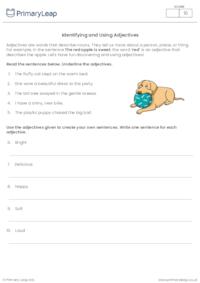
This engaging worksheet is designed for Year 2 students to practise identifying and using adjectives. Suitable for classroom use or home practice, it includes fun activities to help young learners understand and apply adjectives in sentences.Activity 1: Students will read sentences and underline the adjectives. This helps them recognise descriptive words that add detail to nouns.Activity 2: Students will create their own sentences using given adjectives. This encourages them to think creatively and practise using descriptive words in context.This worksheet helps develop descriptive writing skills and enhances vocabulary, making it an excellent resource for teachers, parents, and tutors.
 New
New
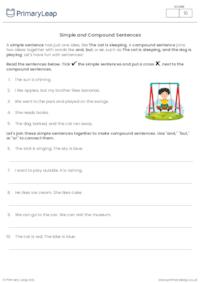
This engaging worksheet will help students practise identifying and creating simple and compound sentences. Suitable for classroom use or home practice, it includes fun activities to help young learners distinguish between simple and compound sentences.Activity 1: Students will identify simple and compound sentences by putting a tick or a cross. Activity 2: Students will combine simple sentences using conjunctions such as "and," "but," or "or" to form compound sentences.This worksheet helps develop sentence structure skills and encourages creative writing, making it an excellent resource for teachers, tutors and parents.
 New
New
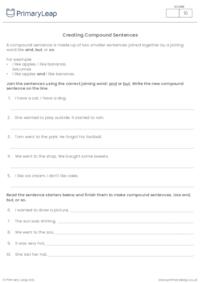
In this fun and engaging Year 2 English worksheet, students will learn how to create compound sentences. Through various activities, they will practice joining simple sentences using "and," "but," or "so." This worksheet is perfect for helping young learners understand the basics of sentence structure and improving their writing skills. Ideal for classroom use or homework assignments, this worksheet is designed to make learning enjoyable and effective.
 New
New
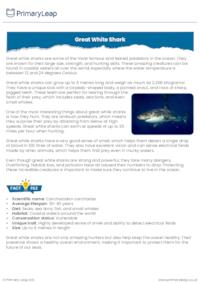
Dive into the exciting world of great white sharks with our Year 6 reading comprehension worksheet. Students will learn about these fascinating ocean predators, their hunting techniques, and the challenges they face. This worksheet combines reading practice with captivating facts about one of the most impressive creatures in the sea, making it perfect for classroom activities or homework.
 New
New
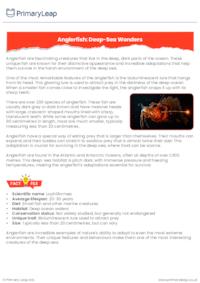
Dive into the mysterious world of the deep sea with our engaging Year 6 reading comprehension worksheet on anglerfish. This handy worksheet will help capture the curiosity of students while enhancing their reading and comprehension skills. Students will learn about the fascinating adaptations and behaviours of anglerfish, making it an educational and enjoyable experience. This activity is perfect for classroom use or homework assignments, providing a fun way to explore the wonders of marine life.
 New
New
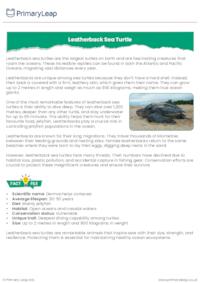
Explore the world of leatherback sea turtles with this engaging reading comprehension worksheet for Year 6 students. Learn about their unique adaptations, impressive migrations, and important role in the ocean ecosystem. This worksheet is perfect for enhancing reading skills and fostering a love for marine life, making it ideal for both classroom and home learning.
 Free
Free
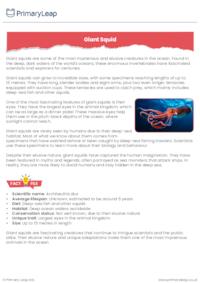
Dive into the mysterious world of giant squids with this engaging reading comprehension worksheet for Year 6 students. Learn about their incredible size, unique adaptations, and the deep-sea habitat they call home. This worksheet is perfect for enhancing reading skills and sparking curiosity about the ocean's most elusive creatures, making it ideal for both classroom and home learning.
 New
New
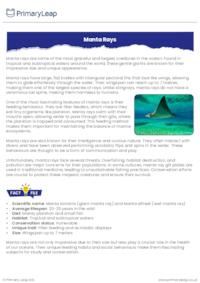
Explore the captivating world of manta rays with this engaging reading comprehension worksheet for Year 6 students. This activity delves into the lives of manta rays, highlighting their unique features and the vital role they play in marine ecosystems. Perfect for enhancing reading skills and fostering a love for marine life, this worksheet is ideal for both classroom and home learning.
 New
New
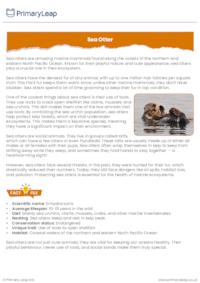
Dive into the world of sea otters with this engaging reading comprehension worksheet for Year 6 students. This activity explores the fascinating lives of sea otters, highlighting their unique traits and important role in marine ecosystems. Perfect for enhancing reading skills, this worksheet is a fun and educational resource for both classroom and home learning.
 New
New
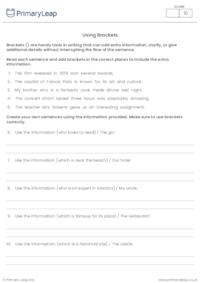
This engaging worksheet on using brackets is perfect for Year 6 students. Through a variety of activities, students will practise adding brackets to sentences, enhancing their writing clarity and detail. This resource helps students understand the importance of these punctuation marks in providing additional information or clarification. It's a great way to enhance writing skills and build confidence in using brackets correctly.
 New
New
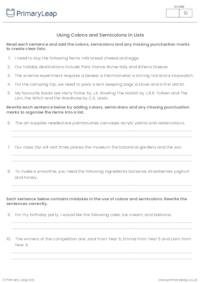
This engaging worksheet on using colons and semicolons in lists is perfect for Year 6 students. Through a variety of activities, students will practise adding colons, semicolons, and other necessary punctuation to sentences, creating organised lists, and fixing punctuation mistakes. This resource helps students understand the importance of clear punctuation in writing and makes learning enjoyable and interactive. It's a great way to enhance writing skills and build confidence in using colons and semicolons correctly.
 New
New
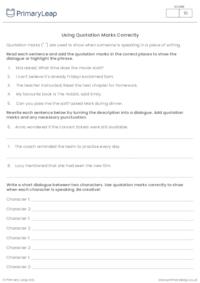
This engaging worksheet is perfect for Year 6 students learning how to use quotation marks correctly. Through a variety of activities, students will practise adding quotation marks to sentences, transforming descriptions into dialogues, and creating their own conversations. This resource helps students understand the importance of punctuation in writing and makes learning enjoyable and interactive.
 New
New
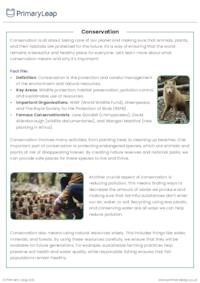
This engaging reading comprehension worksheet about conservation is perfect for Year 5 pupils. It provides important information about what conservation is, why it matters, and how we can all play a part in protecting our planet. With a fact file and a variety of questions, this worksheet helps students recall details, understand concepts in their own words, and think critically. It's an excellent resource for enhancing reading skills and expanding knowledge about environmental conservation.
 Free
Free
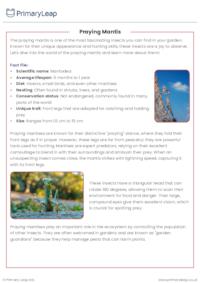
This fun and engaging reading comprehension worksheet about praying mantises is perfect for Year 5 pupils. It provides fascinating facts about these intriguing insects, including their habitats, diets, behaviours, and role in the ecosystem, along with a fact file for quick reference. The worksheet includes a variety of questions to help students recall details, understand concepts in their own words, and think critically. This resource is ideal for enhancing reading skills and expanding knowledge about insects, making learning both educational and enjoyable.
 New
New
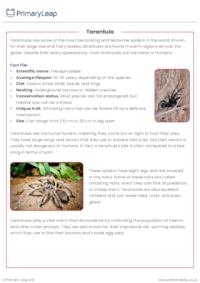
This fun and engaging reading comprehension worksheet about tarantulas is perfect for Year 5 pupils. It provides fascinating facts about these large, hairy spiders, including their habitats, diets, behaviours, and role in the ecosystem, along with a fact file for quick reference. The worksheet includes a variety of questions to help students recall details, understand concepts in their own words, and think critically. This resource is ideal for enhancing reading skills and expanding knowledge about spiders, making learning both educational and enjoyable.
 New
New
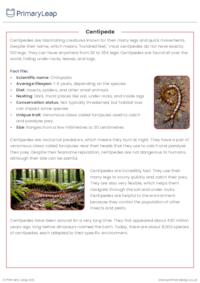
This reading comprehension worksheet about centipedes is perfect for engaging KS2 pupils with fun and fascinating facts about these many-legged creatures. The text provides information on centipedes' habitats, diets, behaviours, and their role in the ecosystem, accompanied by a fact file for quick reference. The worksheet includes a variety of questions to help students recall details, understand concepts in their own words, and think critically. This resource is ideal for enhancing reading skills and expanding knowledge about insects, making learning both educational and enjoyable.
 New
New
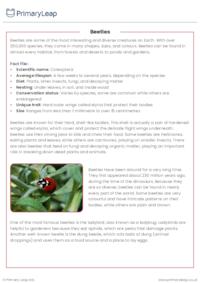
This reading comprehension worksheet about beetles is perfect for engaging KS2 students with fascinating facts about these tiny but mighty creatures. The text provides information on beetles' habitats, diets, behaviours, and their role in the ecosystem, accompanied by a fact file for quick reference. The worksheet includes a variety of questions to help students recall details, understand concepts in their own words, and think critically. This resource is ideal for enhancing reading skills and expanding knowledge about insects.
 New
New
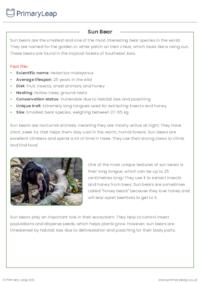
This reading comprehension worksheet about sun bears is perfect for engaging Year 5 pupils with fascinating facts about these unique animals. The text provides information on the sun bear's habitat, diet, behaviour, and their role in the ecosystem, accompanied by a fact file for quick reference. The worksheet includes a variety of questions to help students recall details, understand concepts in their own words, and think critically. This resource is ideal for enhancing reading skills and expanding knowledge about wildlife.Benefits:Enhances reading comprehension skillsPromotes critical thinking and information retentionProvides engaging and educational content about sun bearsEncourages interest in wildlife and conservation
 New
New
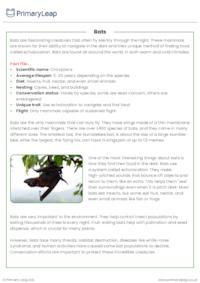
This reading comprehension worksheet about bats is perfect for engaging KS2 pupils with intriguing facts about these nocturnal flyers. The text explains the bat's unique traits, echolocation, and their importance to the environment, accompanied by a fact file for quick reference. The worksheet includes a variety of questions to help students recall information, understand concepts in their own words, and think critically. This resource is ideal for enhancing reading skills and expanding knowledge about wildlife.Benefits:Enhances reading comprehension skillsPromotes critical thinking and information retentionProvides engaging and educational content about batsEncourages interest in wildlife and conservation
 New
New
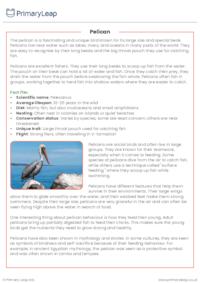
This KS2 reading comprehension worksheet invites pupils to explore the fascinating world of pelicans. The text offers engaging information about the pelican's habitat, diet, behaviour, and cultural significance, complete with a fact file for quick reference. The accompanying questions encourage students to recall details, explain concepts in their own words, and apply critical thinking. This resource is ideal for enhancing reading skills and expanding knowledge about wildlife.
 New
New
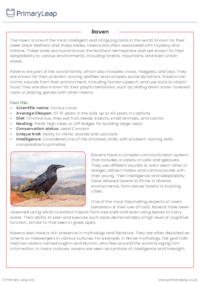
This handy reading comprehension worksheet will help to enhance Year 5 pupils' understanding of the raven, focusing on its intelligence, behaviours, and significance in mythology. The text is accompanied by a fact file and engaging questions that challenge students to recall details, explain concepts in their own words, and use critical thinking to differentiate between similar ideas. The worksheet includes a variety of question types to maintain student interest and promote a deeper understanding of the content.
 Free
Free
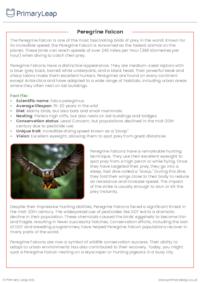
This reading comprehension worksheet is designed to enhance Year 5 pupils' understanding of the Peregrine Falcon, focusing on its unique traits, hunting techniques, and conservation status. The text is accompanied by a fact file and engaging questions that challenge students to recall details, explain concepts in their own words, and use critical thinking to differentiate between similar ideas. The worksheet includes a variety of question types to maintain student interest and promote a deeper understanding of the content.
 New
New
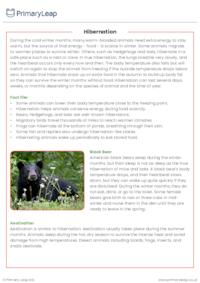
This reading comprehension worksheet is designed to enhance Year 5 pupils' understanding of how animals survive during extreme weather conditions. The text provides detailed information on hibernation, aestivation, and the specific behaviours of animals like black bears. The worksheet includes a fact file for engaging learning, followed by questions that challenge students to recall details, explain concepts in their own words, and differentiate between similar survival strategies. This resource aims to develop critical thinking and comprehension skills, making it suitable for classroom and home use.
 New
New
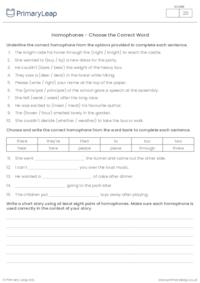
This worksheet helps students master the correct usage of homophones. Through engaging activities, students will practise distinguishing between homophones and using them correctly in sentences. They will fill in the blanks, match sentences with the correct homophones, and write a short story incorporating multiple homophone pairs. These activities reinforce their understanding of word meanings and usage. This resource is ideal for classroom or home use, providing a fun and challenging way for Year 5 pupils to enhance their spelling and language skills.
 New
New
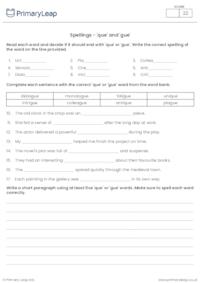
This worksheet helps students master the correct usage of 'que' and 'gue' endings. Through a series of activities, students will practise distinguishing between words ending in 'que' and 'gue', enhancing their vocabulary and spelling skills. They will complete sentences using these words, reinforcing their understanding of word meanings and usage. Additionally, a short writing exercise encourages students to use multiple 'que' and 'gue' words in context, promoting creative thinking and writing fluency. This resource is ideal for classroom or home use, providing a fun and engaging way for Year 5 pupils to develop their language skills.
 New
New
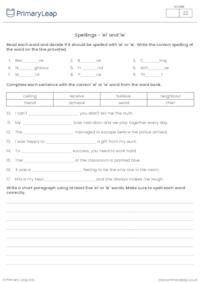
This worksheet helps students master the correct usage of 'ei' and 'ie' spellings. Through a series of activities, students will practise distinguishing between words spelled with 'ei' and 'ie', enhancing their vocabulary and spelling skills. They will complete sentences using these words, reinforcing their understanding of word meanings and usage. Additionally, a short writing exercise encourages students to use multiple 'ei' and 'ie' words in context, promoting creative thinking and writing fluency. This resource is ideal for classroom or home use, providing a fun and engaging way for Year 5 pupils to develop their language skills.
 New
New
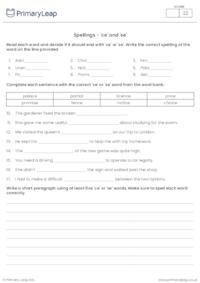
This worksheet helps students master the correct usage of the suffixes '-ce' and '-se'. Through a series of activities, students will practise distinguishing between words ending in '-ce' and '-se', enhancing their vocabulary and spelling skills. They will complete sentences using these words, reinforcing their understanding of word meanings and usage. Additionally, a short writing exercise encourages students to use multiple '-ce' and '-se' words in context, promoting creative thinking and writing fluency. This resource is ideal for classroom or home use, providing a fun and engaging way for Year 5 pupils to develop their language skills.
 New
New
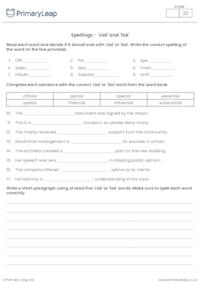
This worksheet helps students master the correct usage of the suffixes '-cial' and '-tial'. Through a series of activities, students will practise distinguishing between words ending in '-cial' and '-tial', enhancing their vocabulary and spelling skills. They will complete sentences using these words, reinforcing their understanding of word meanings and usage. Additionally, a short writing exercise encourages students to use multiple '-cial' and '-tial' words in context, promoting creative thinking and writing fluency. This resource is ideal for classroom or home use, providing a fun and engaging way for Year 5 pupils to develop their language skills.
 New
New
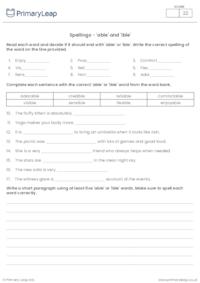
This handy worksheet focuses on helping students master the correct usage of the suffixes '-able' and '-ible'. Through a variety of activities, students will practise distinguishing between words ending in '-able' and '-ible', enhancing their vocabulary and spelling skills. They will complete sentences using these words, reinforcing their understanding of word meanings and usage. Additionally, a short writing exercise encourages students to use multiple '-able' and '-ible' words in context, promoting creative thinking and writing fluency. This resource is ideal for classroom or home use, providing a fun and engaging way for Year 5 pupils to develop their language skills.
 New
New
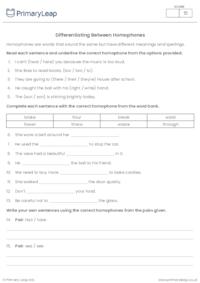
This worksheet helps students differentiate between common homophones, enhancing their vocabulary, grammar, and writing skills. Through engaging activities, pupils will learn to choose the correct homophone in sentences, fill in blanks with appropriate words, and create their own sentences. Suitable for both classroom and home use, this worksheet offers a fun and interactive way to master homophones.
 New
New
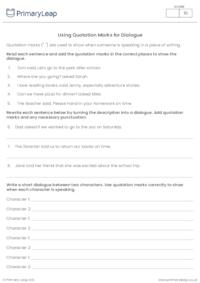
This worksheet helps students practise using quotation marks correctly in dialogue. Through engaging activities, pupils will learn to punctuate dialogue properly, enhancing their grammar and writing skills. Suitable for both classroom and home use, this worksheet offers a fun and interactive way to improve punctuation and dialogue writing.




Check out our ready-to-use worksheets that can be used in the classroom or at home. Simply download or print and watch your child’s confidence grow with our easy to follow printables.


One of the best things about printable worksheets is that they make learning fun and easy. Explore our educational resources based on and keep your children learning through these fun and engaging exercises.


Our printable worksheets are designed for progressive learning. Our engaging content enables a child to learn at their own speed and gain confidence quickly. When we help a child believe in themselves, we empower them for life.


Printable worksheets are a great way to enhance creativity and improve a child’s knowledge. Help your child learn more about with this great selection of worksheets designed to help children succeed.
An email has been sent to your account please activate your account to continue.

PrimaryLeap has introduced a new interactive learning platform and would like to offer you a completely Free Upgrade.
We understand that you may only want to use our services for worksheets and may not want to upgrade your account.
But if you are interested in trying out our new services then you're just a click away.
An email has been sent to your account please activate your account to continue.
You've answered
and have 2 Questions remaining
Import multiple students information through a CSV File. Browse or drag .CSV file below.